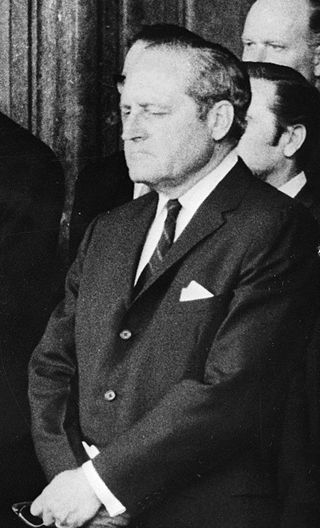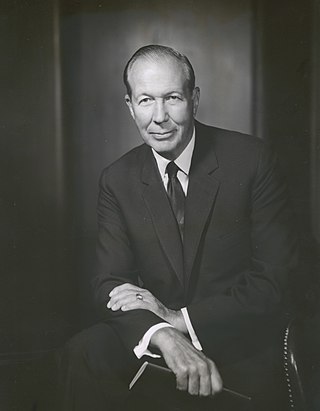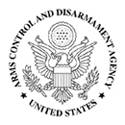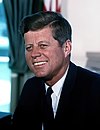
The Mutual Security Act of 1951 launched a major American foreign aid program, 1951–61, of grants to numerous countries. It largely replaced the Marshall Plan. The main goal was to help poor countries develop and to contain the spread of communism. It was signed on October 10, 1951, by President Harry S. Truman. Annual authorizations were about $7.5 billion, out of a GDP of $340bn in 1951, for military, economic, and technical foreign aid to American allies. The aid was aimed primarily at shoring up Western Europe, as the Cold War developed. In 1961 it was replaced by a new foreign aid program, the Foreign Assistance Act of 1961, which created the Agency for International Development (AID), and focused more on Latin America.

The Mutual Defense Assistance Act was a United States Act of Congress signed by President Harry S. Truman on 6 October 1949. For U.S. foreign policy, it was the first U.S. military foreign aid legislation of the Cold War era, and initially to Europe. The Act followed Truman's signing of the Economic Cooperation Act, on April 3, 1948, which provided non-military, economic reconstruction and development aid to Europe.

Paul Henry Nitze was an American businessman and government official who served as United States Deputy Secretary of Defense, U.S. Secretary of the Navy, and Director of Policy Planning for the U.S. State Department. He is best known for being the principal author of NSC 68 and the co-founder of Team B. He helped shape U.S. Cold War defense policy over the course of numerous presidential administrations.

Adrian Sanford Fisher was an American lawyer and federal public servant, who served from the late 1930s through the early 1980s. He was associated with the Department of War and Department of State throughout his professional career. He participated in the U.S. government's decision to carry out Japanese-American internment and the international (1945–46) Nuremberg trial, and in State Department Cold War activities during the Harry S. Truman administration. He was the State Department Legal Adviser under Secretary of State Dean Acheson. During the John F. Kennedy, Lyndon B. Johnson and Jimmy Carter administrations, Fisher was directly involved in the negotiations of international nuclear testing and non-proliferation agreements.

Gerard Coad Smith was an American attorney and defense expert who served as the chief U.S. delegate to the Strategic Arms Limitation Talks (SALT) in 1969 and the first U.S. Chairman of the Trilateral Commission. He was awarded the Presidential Medal of Freedom on January 16, 1981 by President Jimmy Carter.

The Foreign Assistance Act is a United States law governing foreign aid policy. It outlined the political and ideological principles of U.S. foreign aid, significantly overhauled and reorganized the structure U.S. foreign assistance programs, legally distinguished military from nonmilitary aid, and created a new agency, the United States Agency for International Development (USAID) to administer nonmilitary economic assistance programs. Following its enactment by Congress on September 4, 1961, President John F. Kennedy signed the Act into law on November 3, 1961, issuing Executive Order 10973 detailing the reorganization.

The Under Secretary for Arms Control and International Security (T) is a position within the U.S. Department of State that serves as Senior Adviser to the President and the Secretary of State for Arms Control, Nonproliferation, and Disarmament.

The Bureau of International Security and Nonproliferation (ISN) is a bureau within the United States Department of State responsible for managing a broad range of nonproliferation and counterproliferation functions. The bureau leads U.S. efforts to prevent the spread of weapons of mass destruction, their delivery systems, advanced conventional weapons, and related materials, technologies, and expertise.

The Assistant Secretary of State for Arms Control, Verification and Compliance is the head of the Bureau of Arms Control, Verification and Compliance. The position was created on December 12, 1999, by Secretary Albright as the Assistant Secretary of State for Verification and Compliance. The Bureau became fully operational on February 1, 2000, and was first known as the Verification and Compliance Bureau. Within the department, the Assistant Secretary is responsible for all matters relating to the supervision of verification and compliance with international arms control, nonproliferation, and disarmament agreements. The bureau was given its current name during the Obama administration.

The Arms Export Control Act of 1976 gives the President of the United States the authority to control the import and export of defense articles and defense services. The H.R. 13680 legislation was passed by the 94th Congressional session and enacted into law by the 38th President of the United States Gerald R. Ford on June 30, 1976.

Jack Foust Matlock Jr. is an American former ambassador, career Foreign Service Officer, a teacher, a historian, and a linguist. He was a specialist in Soviet affairs during some of the most tumultuous years of the Cold War, and served as the U.S. Ambassador to the Soviet Union from 1987 to 1991.

Paula Adamo DeSutter was United States Assistant Secretary of State for Verification, Compliance, and Implementation from 2002 to 2009.

Ambassador Ronald Frank Lehman II is currently Director of the Center for Global Security Research at the United States Department of Energy's Lawrence Livermore National Laboratory. He is also Chair of the Governing Board of International Science and Technology Center, an intergovernmental organization headquartered in Moscow and is a member of the Department of Defense Threat Reduction Advisory Committee.

The Bureau of Arms Control, Deterrence, and Stability, formerly the Bureau of Arms Control, Verification and Compliance (AVC) is a bureau within the United States Department of State. It is responsible for providing oversight of policy and resources of all matters relating to the verification of compliance, or discovery of noncompliance, with international arms control, nonproliferation, and disarmament agreements.
Thomas Graham Jr. is a former senior U.S. diplomat. Graham was involved in the negotiation of every single international arms control and non-proliferation agreement from 1970 to 1997. This includes the Strategic Arms Limitation Talks, the Strategic Arms Reduction Treaties, the Anti-ballistic missile (ABM) Treaty, Intermediate-Range Nuclear Forces Treaty (INF) Treaty, Treaty on the Non-Proliferation of Nuclear Weapons Treaty (NPT), Treaty on Conventional Armed Forces in Europe (CFE) Treaty and Comprehensive Nuclear-Test-Ban Treaty (CTBT). In 1993, Ambassador Graham served as acting director of the Arms Control and Disarmament Agency (ACDA) from January to November, 1993 and Acting Deputy Director from November, 1993 to July, 1994. From 1994 through 1997, he was president Bill Clinton's special representative for Arms Control, Non-Proliferation, and Disarmament. Graham successfully led the U.S. government efforts to achieve the permanent extension of the NPT in 1995. Graham also served for 15 years as the general counsel of ACDA. Throughout his career, Thomas Graham has worked with six U.S. Presidents including Presidents Richard Nixon, Gerald Ford, Jimmy Carter, Ronald Reagan, George H. W. Bush, and Bill Clinton. Ambassador Graham worked on the negotiation of the Chemical Weapons Convention and the Biological Weapons Convention and managed the Senate approval of the ratification of the Geneva Protocol banning the use of chemical and biological weapons in war, as well as the Biological Weapons Convention.

Bonnie Denise Jenkins is an expert on arms control and nonproliferation of weapons of mass destruction and currently serves as the under secretary of state for arms control and international security affairs. During the Obama administration, she was the U.S. Department of State's coordinator for threat reduction programs in the Bureau of International Security and Nonproliferation.
George Bunn was an American diplomat, lawyer, and nonproliferation expert. He drafted the legislation that created the U.S. Arms Control and Disarmament Agency (ACDA), was one of the lead U.S. negotiators of the nuclear Nonproliferation Treaty (NPT), served as Dean of the law school at the University of Wisconsin–Madison, and spent the last two decades of his career at the Center for International Security and Cooperation at Stanford University.

The Arms Control and Disarmament Act of 1961, 22 U.S.C. § 2551, was created to establish a governing body for the control and reduction of apocalyptic armaments with regards to protect a world from the burdens of armaments and the scourge of war.
Nancy M. O'Fallon Dowdy is an American nuclear physicist who was instrumental in nuclear disarmament negotiations between the U.S. and the Soviet Union after the Cold War. She received her doctorate in physics in 1966. After she developed her career as a nuclear physicist, she turned to politics, where she served as a representative of the United States on a commission for arms control. In 1992 she was nominated by Pres. George H. W. Bush to be Special Representative for Arms Control Negotiation and Disarmament in the aftermath of the Cold War. She has been designated a Fellow of the American Physical Society, in recognition of her role on treaty verification, her research accomplishments and leadership in research, and leadership and service on behalf of women in physics.

William Chapman Foster was an American businessman and high-ranking government official. He served as United States Under Secretary of Commerce and United States Deputy Secretary of Defense under President Harry Truman. Later, he served as the first United States Arms Control and Disarmament Agency director, under Presidents John F. Kennedy and Lyndon B. Johnson.















